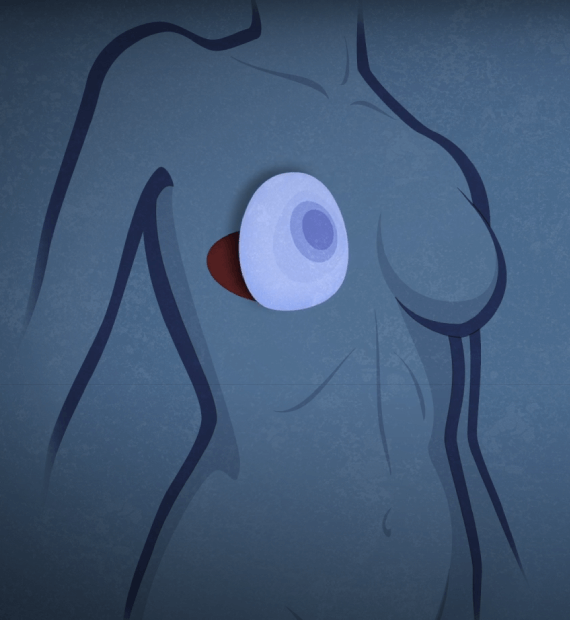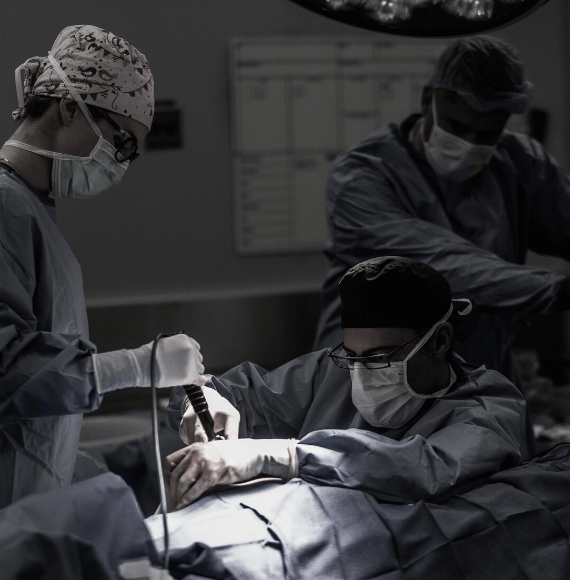Tissue Expander To Implant Breast Reconstruction
The most common method of breast reconstruction currently performed in the US uses tissue expanders and breast implants, usually with an ADM (acellular dermal matrix) such as Alloderm. This is usually performed as a multiple-step procedure starting with tissue expanders. In certain select cases, implant breast reconstruction can be performed in a single-stage (“direct to implant”).
Stages Of Tissue Expander To Implant Breast Reconstruction
Stage One:
The first stage involves placement of tissue expanders either below or above the pectoralis muscle. This can either be done at the time of the mastectomy (for immediate reconstruction patients) or after the mastectomy has healed (for delayed reconstruction patients). Expanders are essentially temporary implants that act as spacers.
The expanders are partially filled at the time of the initial surgery whenever possible. Further expansion is performed as required once the incisions have healed. The length of the expansion process varies depending on the amount of expansion required to reach the optimal breast size, and the type of expander used.
Stage Two:
Once the tissue expanders are adequately filled they are exchanged for the permanent breast implants. Two types of breast implants are available to patients: Saline or Silicone. It is advised that you speak with your plastic surgeon as to which implant would be best for you. Patients who undergo breast reconstruction with implants should be aware that their implants may need to be replaced at a future date.
Fat grafting is frequently included in the second stage to improve the soft tissue “padding” over the final implant. It is extremely helpful in filling in contour defects created by the mastectomy, as well as thickening the fatty layer beneath the skin. A thicker tissue layer over the implant decreases the risk of being able to see the waves in the implant shell, known as “rippling”, and greatly improves the final cosmetic results.

Tissue Expanders Used At PRMA:
Traditional Saline Expanders
Saline expanders are by far the most common type of expander currently used. They can be placed at the same time as the mastectomy or any time later. When placed at the same time as the mastectomy, they are usually partially filled at the time of surgery. Further expansion is performed by the surgeon during several office visits once the patient has healed from surgery. The saline is injected into the expander fill-port through the skin using a syringe.
AirXpanders
The AeroForm Tissue Expander uses carbon dioxide which is released in controlled, small amounts from a cartridge inside the expander. The expansion process is controlled by a hand held remote and can be performed at home by the patient by pressing a single-touch button. This expander has just been approved for use in the US by the FDA.
Key Information:
- Tissue expanders can be placed at the time of the mastectomy or after the mastectomy has healed
- The expanders are partially filled during the initial surgery
- Further expansion is performed in the office (or at home if AirXpanders were used) as required
- Tissue expanders are eventually replaced with permanent breast implants (saline or silicone)
- Patients should be aware that their implants may need to be replaced in the future
- Some patients are candidates for Direct to Implant surgery

Hear From Our Patients

Oh what I would give to have found PRMA before my mastectomy, prosthesis, implants and 6 plus years of not being satisfied. I thank God every day for bringing PRMA into my life and I thank them for doing what they do so well. My wish is that PRMA reaches as many women possible early on so they too can benefit from the amazing work that they do for breast cancer patients. I promote PRMA every chance I have!
Colleen
Deer Park, WA
I would like to say is throughout the whole procedure from the first procedure, to the second procedure, to my final procedures I never felt less than a woman. I like my breast, and so the entire time I never felt like I was not a woman at any point. So definitely I would recommend PRMA to anyone and everyone.
Sarah
San Antonio, TX
I’m super excited and love the results and feel amazing. I want to let anyone listening to this know that I had the worst anxiety before my surgery thinking of everything you can imagine. I can say that this was 100% the right choice for me I love the way that I look. The process was much easier than what I expected.
Laurie
Yorba Linda, CA
I knew I wanted to have a mastectomy, but I didn’t know about breast reconstruction. Dr. Ledoux gave me ALL the options I had, and I really appreciated that!
Jackie
San Antonio, TX
Schedule Your Consultation
Get personalized breast reconstruction recommendations from our board-certified plastic surgeons.
